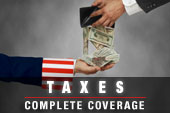Tax reform is one of the few things in Washington these days on which Republicans and Democrats both agree is worth doing. Especially at this time of year, when taxpayers are struggling to file their tax returns, it’s not hard to get applause for promises to make the tax system fairer and simpler. Converting this widespread bipartisan desire into legislation, however, is another matter.

People overwhelmingly desire a balanced federal budget; it is easy for politicians to support this goal but close to impossible for them to find the votes for any specific package of spending cuts or tax increases that would actually bring it about. The same is true of tax reform, especially one that is revenue-neutral, which by definition is a zero-sum game; one person’s or business’s tax cutting reform is necessarily offset by another’s tax increase.
The Holy Grail is the Tax Reform Act of 1986, which broadened the tax base and lowered rates enough that even the net losers supported it. But people forget that all of the net losers, those who paid more taxes as a result of reform, were on the business side. Individuals were net winners.
The problem today is that the driving force for tax reform is the corporate community, which very badly wants to lower the statutory corporate tax rate from 35 percent to, hopefully, 25 percent. But there aren’t enough corporate tax expenditures – special tax provisions unjustified by basic tax principles – to finance such a large rate reduction without losing revenue.
Therefore, to cut corporate taxes, as much as many people believe is necessary, there are really only three options.
• First, revenue neutrality could be abandoned and Congress could simply give corporations a big tax cut. Given the deficit and the opposition of Democrats to a reduction in revenues, this option would seem a nonstarter.
• Second, Congress could do the converse of what it did in 1986 and restrict individual tax expenditures to pay for a cut in corporate taxes. For example, tax rates on dividends and capital gains, which are well below the rates on ordinary income, could be raised. Those with dividends and capital gains are approximately the same people who would benefit from a cut in the corporate tax rate.
According to the Tax Policy Center, taxing dividends and capital gains as ordinary income would finance a reduction in the corporate tax rate to 26 percent and only raise net taxes on the top 1 percent of taxpayers. Nevertheless, I just don’t see this happening, politically.
• Third, Congress could look beyond tax expenditures to core corporate tax deductions such as for depreciation, the write-off for the wearing down of buildings and equipment, or interest on corporate debt. The latter idea, in particular, has garnered some support.
One of the basic problems with corporate taxation is that dividends paid to shareholders are in effect double taxed – first at the corporate level and again when paid out. By contrast, interest paid to bondholders is deductible at the corporate level, but fully taxed at the individual level.
Many economists believe that this disparate treatment has discouraged corporations from raising capital by issuing new stock and instead by selling bonds. This is the principal reason why corporate taxes have fallen from 30 percent of federal revenues in the 1950s to about 12 percent today. In the 1950s, corporate tax revenues equaled 6 percent of the gross domestic product; today they are about 2 percent.
When I worked at the Treasury Department, we called the shift to debt financing from equity financing the “privatization of the corporate income tax.”
One big problem with this shift is that dividend payments can be suspended when there is an economic downturn and corporate profits shrivel. But interest payments must be made regardless of economic circumstances. Many companies go years without paying dividends, but failure to make a single interest payment precisely on schedule can quickly lead to bankruptcy.
Thus many economists believe that corporate indebtedness intensifies economic downturns as companies with too much leverage are forced to sell assets at fire sale prices, lay off workers and close facilities that are only marginally unprofitable to preserve cash at all cost.
It would be better from a macroeconomic point of view if companies replaced at least some of their debt with equity. But the benefits of tax-deductible interest are too great. Thus something needs to be done with the tax code to get them to change their financial structures.
Ideally, we should fully integrate the corporate and individual income taxes. Under such a system, all corporate profits would be attributable to shareholders whether paid out as dividends or not. Net operating losses would also be attributable to shareholders and deductible on individual returns. This would completely eliminate distortions created by the corporate income tax. The present corporate tax could be retained as a withholding tax, with such tax payments also attributable to shareholders.
Some people suggest that we simply abolish the corporate income tax. This is not viable because we can’t afford to give up so much revenue and because incorporation would then become very easy way to avoid paying any income taxes at all.
A half-way measure supported by some economists would be to allow corporations to deduct dividend payments as they now deduct interest payments. The problem here is the same as for cutting the corporate rate – replacing the lost revenue.
As corporations become increasingly convinced that corporate tax reform is impossible without offsets that might make many worse off, their ardor for reform is waning. If corporations cease pushing for tax reform, however, it is highly unlikely that anything will happen.
Even under the best of circumstances, such as those in 1986, tax reform is a long and difficult process. Circumstances now are far less optimal, in part due to deep mistrust and philosophical differences between the White House and congressional Republicans. Therefore, the odds of tax reform are very long indeed.






